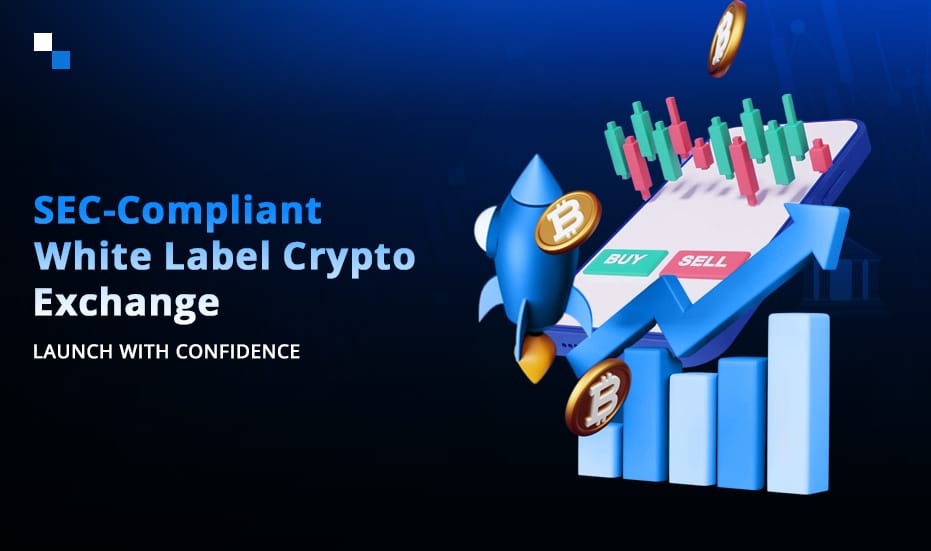
A Comprehensive Guide to Cardano NFT Marketplace Development
December 12, 2023
Metaverse Development on WAX Blockchain: Building Dreams
December 13, 2023In today’s rapidly evolving digital landscape, cryptocurrencies have emerged as a transformative force in the global financial system. As the popularity of cryptocurrencies continues to soar, the demand for reliable and secure cryptocurrency exchanges is gaining heights. However, with the increasing incidents of cyber attacks and hacking, ensuring robust security measures in white label cryptocurrency exchange development has become a crucial aspect to be kept in mind.
Let’s explore the essential security features, trading capabilities, and intuitive UX/UI design that should be integrated into white label exchange software to protect user assets and bolster trust in the decentralized world of virtual currencies.
Security Measures in White Label Cryptocurrency Exchange Development
When choosing a white label cryptocurrency exchange development company, you must discuss these necessary security features to be included in your software:
1.Secure Data Transmission
One of the primary concerns in cryptocurrency exchange development is safeguarding sensitive transactional data. Consider implementing robust Secure Socket Layer (SSL) encryption to your white label exchange software to ensure that all communication between users and the exchange remains confidential and secure. SSL encryption helps prevent data interception and protects users’ personal information and transactional data from malicious actors.
2. Two-Factor Authentication (2FA)
Two-Factor Authentication provides an additional layer of security to the login process. It requires users to provide not only their passwords but also a secondary verification code sent to their registered mobile devices. In this way, white label cryptocurrency exchange mitigate the risk of unauthorized access to user accounts. Implementing 2FA significantly reduces the likelihood of attacks through password theft or brute-force hacking attempts.
3. Cold Storage Wallets
White label cryptocurrency exchanges should employ the use of cold storage wallets to safeguard users’ digital assets from potential breaches. Cold storage involves storing cryptocurrencies offline in an offline hardware device, disconnected from the internet. The risk of cyber attacks targeting hot wallets is minimized by keeping the majority of funds in cold storage, and it enhances overall security.
4. Anti-Money Laundering (AML) and Know Your Customer (KYC) Compliance
To address concerns of illicit activities, a white label cryptocurrency exchange development company should enforce robust AML and KYC procedures. Implementing strong identity verification measures helps mitigate the risk of money laundering, fraud, and terrorist financing. By collecting essential user information and conducting thorough due diligence, such exchanges can foster a more secure and transparent trading environment, instilling trust among users.
5. Multi-Signature Wallets
Integrating multi-signature wallets into white label exchange software offers an additional layer of security. Multi-signature wallets require multiple private keys to authorize transactions, reducing the chances of unauthorized access. With this security measure in place, even if one private key is compromised, hackers cannot access users’ funds without the additional authorized signatures, providing enhanced protection against potential breaches.

Trading Features in White Label Cryptocurrency Exchange Development
White Label Cryptocurrency Exchange Development offers a range of trading features designed to provide a comprehensive and user-friendly trading experience. Here are some key trading features commonly incorporated into white-label cryptocurrency exchanges:
- Order Types and Trading Pairs
To cater to diverse trading needs, white label cryptocurrency exchange should support a wide range of order types, such as market orders, limit orders, stop orders, and more. Additionally, offering a variety of trading pairs allows users to access a broad selection of cryptocurrencies, maximizing their trading opportunities within a single platform. - Liquidity Options
Liquidity is vital for the smooth functioning of any cryptocurrency exchange. By integrating liquidity options, such as order book aggregation, white label exchange platforms ensure that users can execute trades swiftly and at competitive prices. Liquidity providers can be connected through APIs, enabling seamless access to deep order books and enhancing the overall trading experience. - Trading Charts and Indicators
Intuitive and user-friendly trading charts and indicators are essential for effective decision-making and technical analysis. Your white label cryptocurrency exchange development partner should provide comprehensive charting tools, allowing users to visualize price movements, identify trends, and make informed trading decisions. The availability of popular indicators, such as moving averages, Bollinger Bands, and relative strength index (RSI), enhances the trading experience for both novice and experienced traders. - Trading APIs
White label cryptocurrency exchanges should offer robust and well-documented trading APIs to facilitate integration with third-party trading bots, algorithmic trading platforms, and other applications. A well-designed and user-friendly API allows developers to build customized trading solutions, making the exchange platform more versatile and attractive to traders. - Real-Time Market Data and Notifications
Providing users with real-time market data, including price updates, volume, and order book depth, enhances transparency and enables informed decision-making. Additionally, push notifications and alerts for price targets or significant market changes keep users updated, ensuring they never miss critical trading opportunities. - Multi-Currency Support
Supporting a variety of cryptocurrencies allows users to trade a diverse range of digital assets on the platform. Integrating multi-currency support is a pivotal aspect in the development of a white-label exchange. This feature enables users to trade an extensive array of cryptocurrencies, fostering diversity and inclusivity. - Real-Time Market Data
Live and up-to-date market data, including price charts, order book information, and trade history, helps traders make informed decisions. Integrating real-time market data into your white label exchange software empowers traders with up-to-the-minute insights, enabling them to make informed decisions and execute trades swiftly. - Margin Trading
Allows users to trade with borrowed funds, increasing the potential for higher profits (and losses) based on market movements. This feature enables traders to engage in leveraged positions, accessing a broader range of market opportunities while also increasing risk. With Margin Trading, your white label crypto exchange becomes a comprehensive platform catering to both traditional and advanced trading strategies. - Fee Management
The ability to set and manage trading fees, withdrawal fees, and other charges allows platform operators to generate revenue. This feature empowers exchange owners to strike a balance between competitiveness and profitability, providing a dynamic and sustainable platform for cryptocurrency trading.
UI/UX Features
When developing a white label exchange software, the user interface (UI) and user experience (UX) are crucial elements that contribute to the success of the platform. Here are some key UI/UX features that should be considered while discussing with the white label cryptocurrency exchange development company:
- Intuitive Design
A seamless and intuitive design is essential to attract users and provide them with a smooth trading experience. A clutter-free interface, easy navigation, and clear visual hierarchy are fundamental aspects of an intuitive design. - Responsive Design
With the increasing use of mobile devices, a white label cryptocurrency exchange must have a responsive design. Users should be able to access and trade on the platform seamlessly across multiple devices, including smartphones and tablets. - Customizability
A white label exchange should offer customization options that allow businesses to brand the platform according to their requirements. Customizable themes, color schemes, and logos enable entrepreneurs to create a unique and branded exchange that stands out from the competition.
Conclusion
As the cryptocurrency market continues to evolve, security and trading features play a vital role in the success and adoption of white label exchange software. By incorporating robust security measures such as secure data transmission, two-factor authentication, and cold storage wallets, white label exchanges can instill trust and confidence among users.
Furthermore, trading features like diverse order types, liquidity options, and real-time market data elevate the user experience and attract a wider range of traders.
Looking to launch a successful cryptocurrency exchange development? Antier, an ace white label cryptocurrency exchange development company, helps to embrace these essential elements to ensure that your crypto exchange platform is equipped to meet the demands of a rapidly growing cryptocurrency ecosystem while prioritizing the safety and satisfaction of its users. Get a step ahead in the competitive crypto market by developing a robust and secure platform. Request a consultation today!



